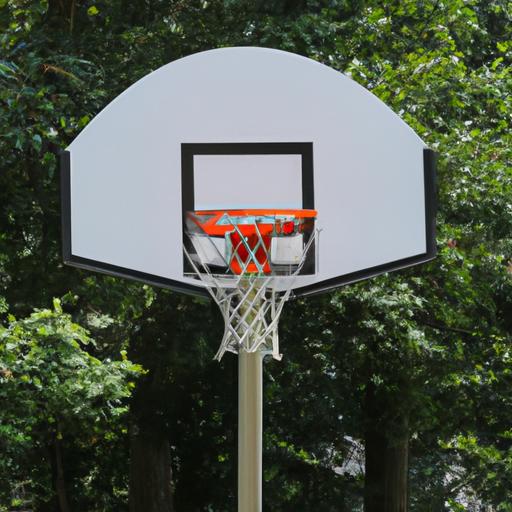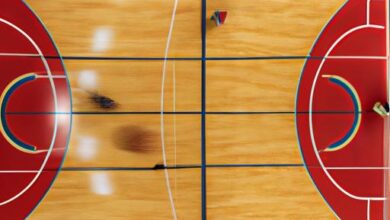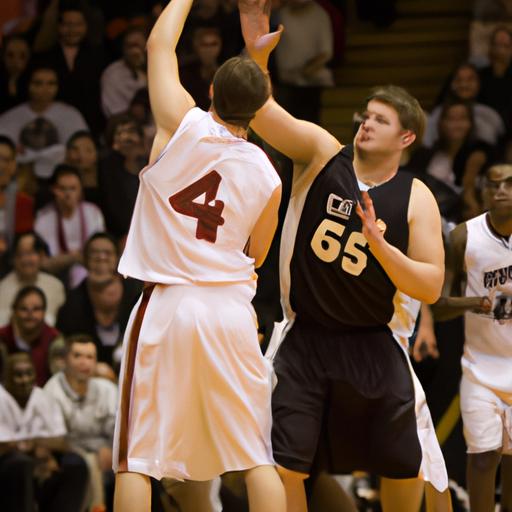How High is a Regulation Basketball Hoop?

Basketball, a game loved and cherished by many, requires precision and skill. But have you ever wondered about the height of a regulation basketball hoop? Whether you’re a fan or a player, understanding the correct hoop height is crucial for an authentic basketball experience. In this article, we’ll delve into the world of regulation basketball hoop heights and why it matters.
So, why is it essential to know the exact height of a regulation basketball hoop? Well, imagine shooting hoops on a hoop that’s too high or too low. It would be like playing a game of darts with a target that keeps changing its position. Frustrating, isn’t it? Knowing the standard height ensures fairness and consistency in the game, allowing players to showcase their skills without any hindrances.
Now, let’s address the burning question: “How high is a regulation basketball hoop?” The official regulation height for basketball hoops, as set by governing bodies such as the International Basketball Federation (FIBA) and the National Basketball Association (NBA), is 10 feet (3.05 meters) from the ground to the rim. This height is consistent across professional, college, and high school levels.
However, it’s important to note that hoop heights may vary for different age groups and levels of play. For younger players, lower hoop heights are often used to accommodate their height and skill level. This allows them to develop their skills gradually and enjoy the game without facing unnecessary difficulties.
In conclusion, knowing the regulation basketball hoop height is vital for both basketball enthusiasts and players alike. It ensures fairness, consistency, and a level playing field. So, the next time you step onto the court, remember to measure your hoop height and adjust accordingly. Stay tuned as we explore more about regulation basketball hoop heights and the factors influencing them in the upcoming sections.
Understanding the Regulation Basketball Hoop Height
Defining Regulation Basketball Hoop
Before we dive deeper into the world of regulation basketball hoop heights, let’s establish what exactly constitutes a regulation hoop. A regulation basketball hoop consists of a rim and a net attached to a backboard. The rim is a circular metal hoop with an attached net, while the backboard is typically made of transparent or opaque material. When we refer to regulation hoop height, we are specifically discussing the distance from the ground to the rim.
The Significance of Standardized Hoop Heights
Why is it crucial to adhere to standardized hoop heights in the sport of basketball? Well, imagine a scenario where every basketball court had a different hoop height. It would create chaos and confusion, making it nearly impossible to compare players’ skills and achievements. Standardized hoop heights ensure consistency across different courts, allowing players to showcase their abilities in a fair and uniform manner.
Governing Bodies and Regulations
The task of establishing and enforcing regulation basketball hoop heights falls upon various governing bodies. Internationally, the International Basketball Federation (FIBA) sets the standards for basketball hoop heights in competitions sanctioned by them. At the professional level, the National Basketball Association (NBA) in the United States also follows FIBA’s guidelines for hoop heights.
Additionally, different countries and organizations may have their own regulations for hoop heights in various levels of play. For example, high school basketball associations often follow the guidelines set by the National Federation of State High School Associations (NFHS) in the United States.
These governing bodies take into account factors such as player safety, fairness, and skill development when determining the appropriate regulation hoop heights. Their aim is to create a level playing field and ensure a consistent experience for players across different competitions and levels of play.
Stay tuned as we explore the official regulation heights for basketball hoops and delve into the factors that influence these heights in the upcoming sections.
The Official Regulation Height for Basketball Hoops
Specific Height Requirement for Regulation Basketball Hoops
When it comes to regulation basketball hoops, the specific height requirement is consistent across professional, college, and high school levels. The official regulation height, as established by governing bodies like FIBA and NBA, is 10 feet (3.05 meters) from the ground to the rim. This standardized height ensures a level playing field, allowing players to showcase their skills without any unfair advantages.
Difference in Hoop Height for Different Age Groups and Levels of Play
While the regulation height of 10 feet remains constant for professional and most competitive levels, variations exist for different age groups to accommodate players’ physical capabilities and skill development. For example, in youth basketball leagues, the hoop height is often adjusted to make the game more accessible and enjoyable for young players. It is common to see hoop heights ranging from 8 to 10 feet for different age divisions.
In high school basketball, the regulation hoop height is typically the same as the professional level, at 10 feet. This prepares aspiring players for the rigors of college and professional basketball. College basketball also adheres to the same 10-foot regulation height, ensuring consistency and uniformity across different levels of play.
Exceptions and Variations in Hoop Height Regulations
While the standard regulation height remains consistent for most official competitions, some exceptions and variations exist. For example, wheelchair basketball has its own set of regulations, considering the physical needs and abilities of wheelchair-bound players. In this adapted version of the sport, the hoop height is lowered to 8 feet (2.44 meters) to accommodate players’ sitting positions.
Additionally, it’s important to note that local recreational leagues and non-competitive settings may have their own variations in hoop height. These adjustments often aim to make the game more enjoyable for players of all skill levels and ages, allowing everyone to participate and have fun.
Understanding the variations in hoop height regulations ensures that players and enthusiasts are aware of the different standards they might encounter. This knowledge enables them to adapt their gameplay accordingly and appreciate the nuances of the sport at various levels. In the following sections, we’ll explore the factors that influence regulation basketball hoop heights and how to adjust them for non-regulation settings.
Factors Influencing Regulation Basketball Hoop Height
When it comes to determining the appropriate height for regulation basketball hoops, several factors come into play. Let’s explore these factors and understand their influence on hoop height.
Impact of Player Safety and Fairness
Player safety is of utmost importance in any sport, and basketball is no exception. The height of a regulation basketball hoop is carefully considered to ensure that players can compete without compromising their well-being. A hoop set too high may lead to excessive jumping and potentially increase the risk of injuries, while a hoop set too low may hinder fair play and limit the game’s dynamics.
Maintaining fairness in the game is another crucial aspect. By setting a standard hoop height, players of all sizes can compete on an equal footing. It balances the game and allows individuals to showcase their skills, regardless of their height or physical attributes.
Role of Physical Development and Skill Progression
As basketball players grow and develop their skills, the hoop height needs to adapt to their changing abilities. For younger players or beginners, lowering the hoop height enables them to practice shooting and develop their technique. It instills confidence and encourages their passion for the game. As they progress, gradually raising the hoop height challenges their skills and pushes them to improve.
Physical development also plays a role in determining hoop height. Younger children have lesser reach and jumping ability compared to older players. Adjusting the hoop height according to their capabilities allows them to enjoy the game and improve gradually as their physical attributes develop.
In summary, several factors influence regulation basketball hoop height. Ensuring player safety, maintaining fairness, and accommodating physical development and skill progression are vital considerations. By understanding these factors, we can appreciate the thought and care put into establishing the appropriate height for basketball hoops. In the next section, we will delve into the official regulations and requirements for regulation basketball hoop height. Stay tuned!
Adjusting Hoop Height for Non-Regulation Settings
Guidelines for Adjusting Hoop Height
When it comes to recreational play or non-regulation settings, you may find yourself in a situation where the standard regulation hoop height of 10 feet doesn’t quite fit the bill. Whether you’re playing in your backyard or organizing a friendly neighborhood game, it’s essential to make necessary adjustments to ensure an enjoyable experience for everyone involved.
To help you navigate these non-regulation settings, here are some guidelines for adjusting hoop height:
-
Consider the Age and Skill Level: If you’re playing with younger children or beginners, it’s advisable to lower the hoop height to accommodate their abilities and enhance their chances of success. A lower hoop not only promotes confidence but also encourages skill development.
-
Maintain Consistency: While adjusting hoop height, it’s crucial to maintain some level of consistency to ensure fair competition. If you’re organizing a tournament or playing with multiple teams, make sure all the hoops are adjusted to the same height throughout the event.
Alternative Hoop Heights for Different Scenarios
Now, let’s explore some alternative hoop heights based on different scenarios:
-
Recreational Play: For casual backyard games or family gatherings, consider adjusting the hoop height to around 7 to 9 feet. This lower height allows players of varying skill levels to participate and enjoy the game while maintaining a sense of challenge.
-
Youth Leagues: In youth basketball leagues, where players are typically between the ages of 8 and 14, adjusting the hoop height to 8 or 9 feet can be beneficial. This modification helps young players develop their skills while still providing a reasonable challenge.
-
Wheelchair Basketball: In the inclusive sport of wheelchair basketball, the regulation hoop height remains the same. However, the rim may be lowered to 8 feet for certain divisions or players with specific needs, ensuring their equal participation and enjoyment.
Remember, these alternative hoop heights are merely suggestions. Ultimately, the goal is to create an environment that fosters engagement, skill development, and fair competition. So, when faced with non-regulation settings, don’t hesitate to make adjustments that cater to the specific needs and abilities of the players involved.
Conclusion
In conclusion, understanding the regulation height of a basketball hoop is essential for any basketball enthusiast or player. By adhering to the standardized height, players can ensure fair and consistent gameplay, allowing their skills to shine without any hindrances.
The official regulation height for basketball hoops, set by governing bodies like FIBA and the NBA, is 10 feet (3.05 meters). This height remains consistent across professional, college, and high school levels. However, it’s important to consider age groups and skill levels when determining hoop heights for younger players.
Knowing the correct height of a regulation basketball hoop enables players to develop their skills effectively and enjoy the game to its fullest potential. It ensures a level playing field and fair competition, allowing everyone to showcase their abilities without any disadvantages.
So, whether you’re a basketball enthusiast, a player, or someone who simply enjoys shooting hoops, take the time to measure your hoop height and make any necessary adjustments. By doing so, you’ll ensure an authentic basketball experience that aligns with the official regulations.
Remember, the height of a regulation basketball hoop matters, and it’s up to us to maintain the integrity of the game. So, get out there, shoot some hoops, and embrace the thrill of basketball with the confidence that you’re playing by the rules.
Conclusion: So above is the How High is a Regulation Basketball Hoop? article. Hopefully with this article you can help you in life, always follow and read our good articles on the website: sports.canadianpharmaciesgen.com



